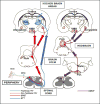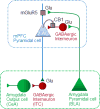The cannabinoid system and pain
- PMID: 28625720
- PMCID: PMC5785108
- DOI: 10.1016/j.neuropharm.2017.06.015
The cannabinoid system and pain
Abstract
Chronic pain states are highly prevalent and yet poorly controlled by currently available analgesics, representing an enormous clinical, societal, and economic burden. Existing pain medications have significant limitations and adverse effects including tolerance, dependence, gastrointestinal dysfunction, cognitive impairment, and a narrow therapeutic window, making the search for novel analgesics ever more important. In this article, we review the role of an important endogenous pain control system, the endocannabinoid (EC) system, in the sensory, emotional, and cognitive aspects of pain. Herein, we briefly cover the discovery of the EC system and its role in pain processing pathways, before concentrating on three areas of current major interest in EC pain research; 1. Pharmacological enhancement of endocannabinoid activity (via blockade of EC metabolism or allosteric modulation of CB1receptors); 2. The EC System and stress-induced modulation of pain; and 3. The EC system & medial prefrontal cortex (mPFC) dysfunction in pain states. Whilst we focus predominantly on the preclinical data, we also include extensive discussion of recent clinical failures of endocannabinoid-related therapies, the future potential of these approaches, and important directions for future research on the EC system and pain. This article is part of the Special Issue entitled "A New Dawn in Cannabinoid Neurobiology".
Keywords: AA-5-HT (PubChem CID: 10027372); Amygdala; BIA-102474 (PubChem CID: 46831476); Cannabinoid; Cortical control of pain; Endocannabinoid; FAAH; JZL184 (PubChem CID: 25021165); JZL195 (PubChem CID: 46232606); MAGL; MJN110 (PubChem CID: 71722059); PF-04457845 (PubChem CID: 24771824); Pain; Stress; Stress-induced analgesia; Stress-induced hyperalgesia; URB597 (PubChem CID: 1383884); URB937 (PubChem CID: 53394762); mGluR5; mPFC.
Copyright © 2017 Elsevier Ltd. All rights reserved.
Figures


Comment in
-
Dual FAAH and MAGL inhibition might play a key role in visceral pain.Turk J Gastroenterol. 2018 Sep;29(5):625-626. doi: 10.5152/tjg.2018.18401. Turk J Gastroenterol. 2018. PMID: 30260791 Free PMC article. No abstract available.
References
-
- Agarwal N, Pacher P, Tegeder I, Amaya F, Constantin CE, Brenner GJ, Rubino T, Michalski CW, Marsicano G, Monory K, Mackie K, Marian C, Batkai S, Parolaro D, Fischer MJ, Reeh P, Kunos G, Kress M, Lutz B, Woolf CJ, Kuner R. Cannabinoids mediate analgesia largely via peripheral type 1 cannabinoid receptors in nociceptors. Nature Neuroscience. 2007;10:870–879. - PMC - PubMed
-
- Ahn K, Johnson DS, Mileni M, Beidler D, Long JZ, McKinney MK, Weerapana E, Sadagopan N, Liimatta M, Smith SE, Lazerwith S, Stiff C, Kamtekar S, Bhattacharya K, Zhang Y, Swaney S, Van Becelaere K, Stevens RC, Cravatt BF. Discovery and Characterization of a Highly Selective FAAH Inhibitor that Reduces Inflammatory Pain. Chemistry & Biology. 2009;16:411–420. - PMC - PubMed
-
- Ahn K, Smith SE, Liimatta MB, Beidler D, Sadagopan N, Dudley DT, Young T, Wren P, Zhang Y, Swaney S, Van Becelaere K, Blankman JL, Nomura DK, Bhattachar SN, Stiff C, Nomanbhoy TK, Weerapana E, Johnson DS, Cravatt BF. Mechanistic and Pharmacological Characterization of PF-04457845: A Highly Potent and Selective Fatty Acid Amide Hydrolase Inhibitor That Reduces Inflammatory and Noninflammatory Pain. Journal of Pharmacology and Experimental Therapeutics. 2011;338:114–124. - PMC - PubMed
Publication types
MeSH terms
Substances
Grants and funding
LinkOut - more resources
Full Text Sources
Other Literature Sources
Medical

